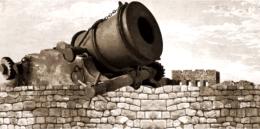[notice]A monthly column by Marcel van der Watt, lecturer in the Department of Police Practice at UNISA, former police detective, and current member of the Gauteng Rapid Response Task Team for Human Trafficking.[/notice]
The use of tales and rhymes as catalysts for deeper understanding or bringing across a particular message has been part of most cultures for centuries. One such rhyme is the story of Humpty Dumpty which still lives on in many households, especially those where a child enters the pre-primary or crèche phase of schooling. The wording of the rhyme is as follows:
Humpty Dumpty sat on a wall,
Humpty Dumpty had a great fall.
All the King’s horses, and all the King’s men
Couldn’t put Humpty together again!
In harmony with most perceptions of Humpty Dumpty as being an egg, the term ‘Humpty Dumpty’ was used colloquially in fifteenth century England to describe someone that was overweight. Probably one of the most influential images of Humpty Dumpty was the one illustrated by Lewis Caroll in the novel ‘Alice through the looking-glass’. The rhyme has great potential as an ‘icebreaker’ especially when working with children and I have personally used it during training to bring across a very specific message to those involved in counter human trafficking activities. In a moment of curiosity before a recent training seminar I decided to delve into the meaning and origin of this well-known rhyme. I was surprised to find that there was in fact an ‘original’ Humpty Dumpty and that he (probably not ‘she’) was in fact not an egg or some form of personalised human character as found in animated movies or storybooks. The ‘original’ Humpty Dumpty was in fact believed to be a large cannon.
The ‘original’ Humpty Dumpty
The following extract is taken from ‘The History and Origins of the Rhyme’.
 It (the cannon) was used during the English Civil War (1642 – 1649) in the Siege of Colchester (13 Jun 1648 – 27 Aug 1648). Colchester was strongly fortified by the Royalists and was laid to siege by the Parliamentarians (Roundheads). In 1648 the town of Colchester was a walled town with a castle and several churches and was protected by the city wall. Standing immediately adjacent to the city wall, was St Mary’s Church. A huge cannon, colloquially called Humpty Dumpty, was strategically placed on the wall next to St Mary’s Church. The historical events detailing the siege of Colchester are well documented – references to the cannon (Humpty Dumpty) are as follows:
It (the cannon) was used during the English Civil War (1642 – 1649) in the Siege of Colchester (13 Jun 1648 – 27 Aug 1648). Colchester was strongly fortified by the Royalists and was laid to siege by the Parliamentarians (Roundheads). In 1648 the town of Colchester was a walled town with a castle and several churches and was protected by the city wall. Standing immediately adjacent to the city wall, was St Mary’s Church. A huge cannon, colloquially called Humpty Dumpty, was strategically placed on the wall next to St Mary’s Church. The historical events detailing the siege of Colchester are well documented – references to the cannon (Humpty Dumpty) are as follows:
- June 15th 1648 – St Mary’s Church is fortified and a large cannon is placed on the roof which was fired by ‘One-Eyed Jack Thompson’;
- July 14th / July 15th 1648 – The Royalist fort within the walls at St Mary’s church is blown to pieces and their main cannon battery ( Humpty Dumpty) is destroyed;
- August 28th 1648 – The Royalists lay down their arms, open the gates of Colchester and surrender to the Parliamentarians;
A shot from a Parliamentary cannon succeeded in damaging the wall beneath Humpty Dumpty which caused the cannon to tumble to the ground. The Royalists, or Cavaliers, ‘all the King’s men’ attempted to raise Humpty Dumpty on to another part of the wall. However, because the cannon, or Humpty Dumpty, was so heavy ‘All the King’s horses and all the King’s men couldn’t put Humpty together again!’ This had a drastic consequence for the Royalists as the strategically important town of Colchester fell to the Parliamentarians after a siege lasting eleven weeks.
The daily battle: Planning and strategising as God’s select
As children of God we are often exposed to situations in life where we need to make immediate decisions despite having access to limited information and experience to guide our choices. During such times we realise the importance of investing in a daily strategy session with our Creator. Being living and active (Hebrews 4:12), God’s Word was relevant 2000 years ago and still is today. It is a source of wisdom and understanding which surpasses the value of any other diagnostic tool available to us in our modern era. Reverting back to the Humpty Dumpty scenario, we learn from the available history that the Royalist main cannon battery (Humpty Dumpty) was destabilised after the wall on which it was placed was damaged. Even though the cannon was ‘strategically’ placed, it is undeniable that an element of vulnerability and exposure was identified and exploited by the Parliamentarian army. Furthermore, subsequent to the fall of Humpty Dumpty we learn of the inability of all the King’s horses and men to reposition Humpty Dumpty to an operational position, leading to the Parliamentarian victory.
Planning and strategy sessions with God expose vulnerable areas in our life and character and nurture a comprehensive response to our daily challenges by providing us with a range of ‘tools’. Not only does it inspire and equip us to be kind, joyful, loyal and disciplined in a demanding universe, but also provides us with inner strength, perseverance and persistence when we’ve missed the mark. The range of ‘tools’ gives us access to response mechanisms which are not naturally our preferred choice, but because of God’s provision we can attain extraordinary results through applying ordinary biblical principles. The King used all his men and all his horses in an attempt to reposition Humpty Dumpty: were these the only tools he had access to?
In preparing for the numerous battles we face, let us ‘finalise our plans through counsel and wage war with sound guidance’ (Proverbs 20:18) whilst pondering the words of Thomas Paine who rightfully argues “An army of principles can penetrate where an army of soldiers cannot”.







